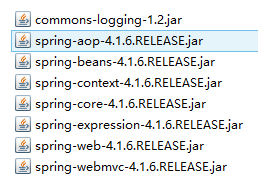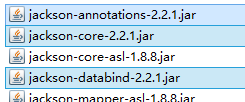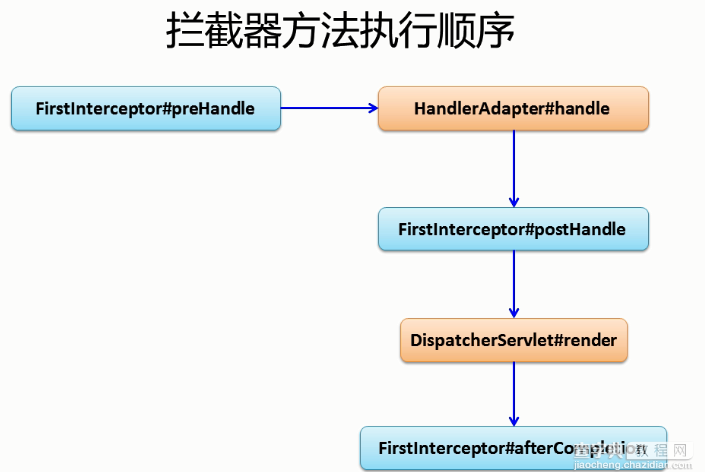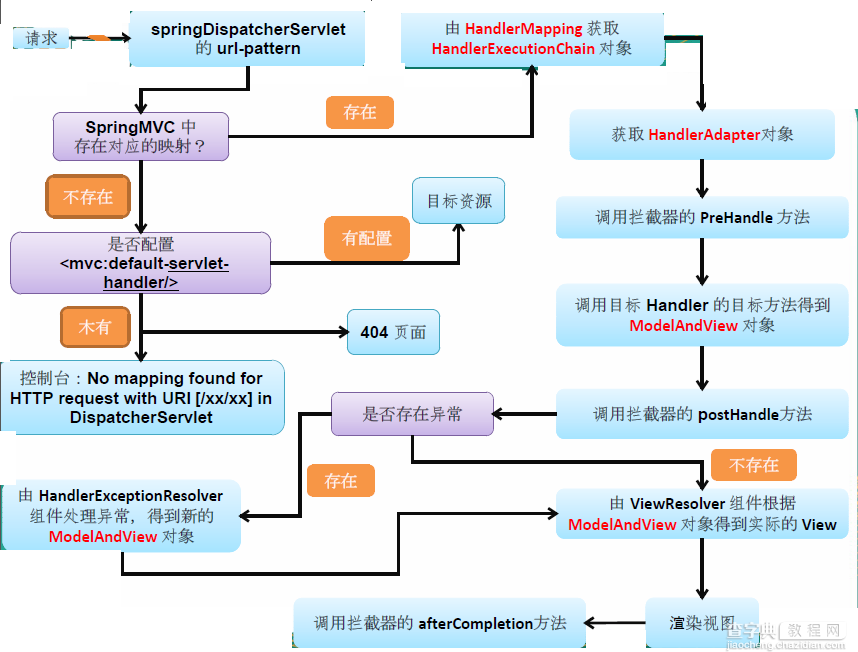一、SpringMVC基础入门,创建一个HelloWorld程序
1.首先,导入SpringMVC需要的jar包。

2.添加Web.xml配置文件中关于SpringMVC的配置
<> <servlet> <servlet-name>springmvc</servlet-name> <servlet-class>org.springframework.web.servlet.DispatcherServlet</servlet-class> <init-param> <param-name>contextConfigLocation</param-name> <param-value>classpath:springmvc-servlet.xml</param-value> </init-param> <> </servlet> <servlet-mapping> <servlet-name>springmvc</servlet-name> <url-pattern>/</url-pattern> </servlet-mapping>
3.在src下添加springmvc-servlet.xml配置文件
<"1.0" encoding="UTF-8"?> <beans xmlns="http://www.springframework.org/schema/beans" xmlns:xsi="http://www.w3.org/2001/XMLSchema-instance" xmlns:context="http://www.springframework.org/schema/context" xmlns:mvc="http://www.springframework.org/schema/mvc" xsi:schemaLocation="http://www.springframework.org/schema/beans http://www.springframework.org/schema/beans/spring-beans.xsd http://www.springframework.org/schema/context http://www.springframework.org/schema/context/spring-context-4.1.xsd http://www.springframework.org/schema/mvc http://www.springframework.org/schema/mvc/spring-mvc-4.1.xsd"> <> <context:component-scan base-package="test.SpringMVC"/> <> <mvc:default-servlet-handler /> <> <mvc:annotation-driven /> <> <bean id="internalResourceViewResolver"> <> <property name="prefix" value="/WEB-INF/jsp/" /> <> <property name="suffix" value=".jsp" /> </bean> </beans>
4.在WEB-INF文件夹下创建名为jsp的文件夹,用来存放jsp视图。创建一个hello.jsp,在body中添加“Hello World”。
5.建立包及Controller,如下所示

6.编写Controller代码
@Controller @RequestMapping("/mvc") public class mvcController { @RequestMapping("/hello") public String hello(){ return "hello"; } }
7.启动服务器,键入http://localhost:8080/项目名/mvc/hello
二、配置解析
1.Dispatcherservlet
DispatcherServlet是前置控制器,配置在web.xml文件中的。拦截匹配的请求,Servlet拦截匹配规则要自已定义,把拦截下来的请求,依据相应的规则分发到目标Controller来处理,是配置spring MVC的第一步。
2.InternalResourceViewResolver
视图名称解析器
3.以上出现的注解
@Controller负责注册一个bean 到spring 上下文中
@RequestMapping 注解为控制器指定可以处理哪些 URL 请求
三、SpringMVC常用注解
@Controller
负责注册一个bean 到spring 上下文中
@RequestMapping
注解为控制器指定可以处理哪些 URL 请求
@RequestBody
该注解用于读取Request请求的body部分数据,使用系统默认配置的HttpMessageConverter进行解析,然后把相应的数据绑定到要返回的对象上,再把HttpMessageConverter返回的对象数据绑定到 controller中方法的参数上
@ResponseBody
该注解用于将Controller的方法返回的对象,通过适当的HttpMessageConverter转换为指定格式后,写入到Response对象的body数据区
@ModelAttribute
在方法定义上使用 @ModelAttribute 注解:Spring MVC 在调用目标处理方法前,会先逐个调用在方法级上标注了@ModelAttribute 的方法
在方法的入参前使用 @ModelAttribute 注解:可以从隐含对象中获取隐含的模型数据中获取对象,再将请求参数 –绑定到对象中,再传入入参将方法入参对象添加到模型中
@RequestParam
在处理方法入参处使用 @RequestParam 可以把请求参 数传递给请求方法
@PathVariable
绑定 URL 占位符到入参
@ExceptionHandler
注解到方法上,出现异常时会执行该方法
@ControllerAdvice
使一个Contoller成为全局的异常处理类,类中用@ExceptionHandler方法注解的方法可以处理所有Controller发生的异常
四、自动匹配参数
//match automatically @RequestMapping("/person") public String toPerson(String name,double age){ System.out.println(name+" "+age); return "hello"; } 五、自动装箱
1.编写一个Person实体类
package test.SpringMVC.model; public class Person { public String getName() { return name; } public void setName(String name) { this.name = name; } public int getAge() { return age; } public void setAge(int age) { this.age = age; } private String name; private int age; }
2.在Controller里编写方法
//boxing automatically @RequestMapping("/person1") public String toPerson(Person p){ System.out.println(p.getName()+" "+p.getAge()); return "hello"; } 六、使用InitBinder来处理Date类型的参数
//the parameter was converted in initBinder @RequestMapping("/date") public String date(Date date){ System.out.println(date); return "hello"; } //At the time of initialization,convert the type "String" to type "date" @InitBinder public void initBinder(ServletRequestDataBinder binder){ binder.registerCustomEditor(Date.class, new CustomDateEditor(new SimpleDateFormat("yyyy-MM-dd"), true)); } 七、向前台传递参数
//pass the parameters to front-end @RequestMapping("/show") public String showPerson(Map<String,Object> map){ Person p =new Person(); map.put("p", p); p.setAge(20); p.setName("jayjay"); return "show"; }
前台可在Request域中取到"p"
八、使用Ajax调用
//pass the parameters to front-end using ajax @RequestMapping("/getPerson") public void getPerson(String name,PrintWriter pw){ pw.write("hello,"+name); } @RequestMapping("/name") public String sayHello(){ return "name"; }
前台用下面的Jquery代码调用
$(function(){ $("#btn").click(function(){ $.post("mvc/getPerson",{name:$("#name").val()},function(data){ alert(data); }); }); }); 九、在Controller中使用redirect方式处理请求
//redirect @RequestMapping("/redirect") public String redirect(){ return "redirect:hello"; } 十、文件上传
1.需要导入两个jar包

2.在SpringMVC配置文件中加入
<> <bean id="multipartResolver"> <property name="maxUploadSize" value="102400000"></property> </bean>
3.方法代码
@RequestMapping(value="/upload",method=RequestMethod.POST) public String upload(HttpServletRequest req) throws Exception{ MultipartHttpServletRequest mreq = (MultipartHttpServletRequest)req; MultipartFile file = mreq.getFile("file"); String fileName = file.getOriginalFilename(); SimpleDateFormat sdf = new SimpleDateFormat("yyyyMMddHHmmss"); FileOutputStream fos = new FileOutputStream(req.getSession().getServletContext().getRealPath("/")+ "upload/"+sdf.format(new Date())+fileName.substring(fileName.lastIndexOf('.'))); fos.write(file.getBytes()); fos.flush(); fos.close(); return "hello"; }
4.前台form表单
<form action="mvc/upload" method="post" enctype="multipart/form-data"> <input type="file" name="file"><br> <input type="submit" value="submit"> </form> 十一、使用@RequestParam注解指定参数的name
@Controller @RequestMapping("/test") public class mvcController1 { @RequestMapping(value="/param") public String testRequestParam(@RequestParam(value="id") Integer id, @RequestParam(value="name")String name){ System.out.println(id+" "+name); return "/hello"; } } 十二、RESTFul风格的SringMVC
1.RestController
@Controller @RequestMapping("/rest") public class RestController { @RequestMapping(value="/user/{id}",method=RequestMethod.GET) public String get(@PathVariable("id") Integer id){ System.out.println("get"+id); return "/hello"; } @RequestMapping(value="/user/{id}",method=RequestMethod.POST) public String post(@PathVariable("id") Integer id){ System.out.println("post"+id); return "/hello"; } @RequestMapping(value="/user/{id}",method=RequestMethod.PUT) public String put(@PathVariable("id") Integer id){ System.out.println("put"+id); return "/hello"; } @RequestMapping(value="/user/{id}",method=RequestMethod.DELETE) public String delete(@PathVariable("id") Integer id){ System.out.println("delete"+id); return "/hello"; } }
2.form表单发送put和delete请求
在web.xml中配置
<> <filter> <filter-name>HiddenHttpMethodFilter</filter-name> <filter-class>org.springframework.web.filter.HiddenHttpMethodFilter</filter-class> </filter> <filter-mapping> <filter-name>HiddenHttpMethodFilter</filter-name> <url-pattern>/*</url-pattern> </filter-mapping>
在前台可以用以下代码产生请求
<form action="rest/user/1" method="post"> <input type="hidden" name="_method" value="PUT"> <input type="submit" value="put"> </form> <form action="rest/user/1" method="post"> <input type="submit" value="post"> </form> <form action="rest/user/1" method="get"> <input type="submit" value="get"> </form> <form action="rest/user/1" method="post"> <input type="hidden" name="_method" value="DELETE"> <input type="submit" value="delete"> </form> 十三、返回json格式的字符串
1.导入以下jar包

2.方法代码
@Controller @RequestMapping("/json") public class jsonController { @ResponseBody @RequestMapping("/user") public User get(){ User u = new User(); u.setId(1); u.setName("jayjay"); u.setBirth(new Date()); return u; } } 十四、异常的处理
1.处理局部异常(Controller内)
@ExceptionHandler public ModelAndView exceptionHandler(Exception ex){ ModelAndView mv = new ModelAndView("error"); mv.addObject("exception", ex); System.out.println("in testExceptionHandler"); return mv; } @RequestMapping("/error") public String error(){ int i = 5/0; return "hello"; }
2.处理全局异常(所有Controller)
@ControllerAdvice public class testControllerAdvice { @ExceptionHandler public ModelAndView exceptionHandler(Exception ex){ ModelAndView mv = new ModelAndView("error"); mv.addObject("exception", ex); System.out.println("in testControllerAdvice"); return mv; } }
3.另一种处理全局异常的方法
在SpringMVC配置文件中配置
<> <bean> <property name="exceptionMappings"> <props> <prop key="java.lang.ArithmeticException">error</prop> </props> </property> </bean>
error是出错页面
十五、设置一个自定义拦截器
1.创建一个MyInterceptor类,并实现HandlerInterceptor接口
public class MyInterceptor implements HandlerInterceptor { @Override public void afterCompletion(HttpServletRequest arg0, HttpServletResponse arg1, Object arg2, Exception arg3) throws Exception { System.out.println("afterCompletion"); } @Override public void postHandle(HttpServletRequest arg0, HttpServletResponse arg1, Object arg2, ModelAndView arg3) throws Exception { System.out.println("postHandle"); } @Override public boolean preHandle(HttpServletRequest arg0, HttpServletResponse arg1, Object arg2) throws Exception { System.out.println("preHandle"); return true; } }
2.在SpringMVC的配置文件中配置
<> <mvc:interceptors> <mvc:interceptor> <mvc:mapping path="/mvc/**"/> <bean></bean>gt; </mvc:interceptor> </mvc:interceptors>
3.拦截器执行顺序

十六、表单的验证(使用Hibernate-validate)及国际化
1.导入Hibernate-validate需要的jar包

(未选中不用导入)

2.编写实体类User并加上验证注解
public class User { public int getId() { return id; } public void setId(int id) { this.id = id; } public String getName() { return name; } public void setName(String name) { this.name = name; } public Date getBirth() { return birth; } public void setBirth(Date birth) { this.birth = birth; } @Override public String toString() { return "User [id=" + id + ", name=" + name + ", birth=" + birth + "]"; } private int id; @NotEmpty private String name; @Past @DateTimeFormat(pattern="yyyy-MM-dd") private Date birth; }
ps:@Past表示时间必须是一个过去值
3.在jsp中使用SpringMVC的form表单
<form:form action="form/add" method="post" modelAttribute="user"> id:<form:input path="id"/><form:errors path="id"/><br> name:<form:input path="name"/><form:errors path="name"/><br> birth:<form:input path="birth"/><form:errors path="birth"/> <input type="submit" value="submit"> </form:form>
ps:path对应name
4.Controller中代码
@Controller @RequestMapping("/form") public class formController { @RequestMapping(value="/add",method=RequestMethod.POST) public String add(@Valid User u,BindingResult br){ if(br.getErrorCount()>0){ return "addUser"; } return "showUser"; } @RequestMapping(value="/add",method=RequestMethod.GET) public String add(Map<String,Object> map){ map.put("user",new User()); return "addUser"; } }
ps:
1.因为jsp中使用了modelAttribute属性,所以必须在request域中有一个"user".
2.@Valid 表示按照在实体上标记的注解验证参数
3.返回到原页面错误信息回回显,表单也会回显
5.错误信息自定义
在src目录下添加locale.properties
NotEmpty.user.name=name can't not be empty Past.user.birth=birth should be a past value DateTimeFormat.user.birth=the format of input is wrong typeMismatch.user.birth=the format of input is wrong typeMismatch.user.id=the format of input is wrong
在SpringMVC配置文件中配置
<> <bean id="messageSource"> <property name="basename" value="locale"></property> </bean>
6.国际化显示
在src下添加locale_zh_CN.properties
username=账号 password=密码
locale.properties中添加
username=user name password=password
创建一个locale.jsp
<body> <fmt:message key="username"></fmt:message> <fmt:message key="password"></fmt:message> </body>
在SpringMVC中配置
<> <mvc:view-controller path="/locale" view-name="locale"/>
让locale.jsp在WEB-INF下也能直接访问
最后,访问locale.jsp,切换浏览器语言,能看到账号和密码的语言也切换了
十七、压轴大戏--整合SpringIOC和SpringMVC
1.创建一个test.SpringMVC.integrate的包用来演示整合,并创建各类

2.User实体类
public class User { public int getId() { return id; } public void setId(int id) { this.id = id; } public String getName() { return name; } public void setName(String name) { this.name = name; } public Date getBirth() { return birth; } public void setBirth(Date birth) { this.birth = birth; } @Override public String toString() { return "User [id=" + id + ", name=" + name + ", birth=" + birth + "]"; } private int id; @NotEmpty private String name; @Past @DateTimeFormat(pattern="yyyy-MM-dd") private Date birth; }
3.UserService类
@Component public class UserService { public UserService(){ System.out.println("UserService Constructor...nnnnnn"); } public void save(){ System.out.println("save"); } }
4.UserController
@Controller @RequestMapping("/integrate") public class UserController { @Autowired private UserService userService; @RequestMapping("/user") public String saveUser(@RequestBody @ModelAttribute User u){ System.out.println(u); userService.save(); return "hello"; } }
5.Spring配置文件
在src目录下创建SpringIOC的配置文件applicationContext.xml
<"1.0" encoding="UTF-8"?> <beans xmlns="http://www.springframework.org/schema/beans" xmlns:xsi="http://www.w3.org/2001/XMLSchema-instance" xsi:schemaLocation="http://www.springframework.org/schema/beans http://www.springframework.org/schema/beans/spring-beans.xsd http://www.springframework.org/schema/util http://www.springframework.org/schema/util/spring-util-4.0.xsd http://www.springframework.org/schema/context http://www.springframework.org/schema/context/spring-context.xsd " xmlns:util="http://www.springframework.org/schema/util" xmlns:p="http://www.springframework.org/schema/p" xmlns:context="http://www.springframework.org/schema/context" > <context:component-scan base-package="test.SpringMVC.integrate"> <context:exclude-filter type="annotation" expression="org.springframework.stereotype.Controller"/> <context:exclude-filter type="annotation" expression="org.springframework.web.bind.annotation.ControllerAdvice"/> </context:component-scan> </beans>
在Web.xml中添加配置
<> <listener> <listener-class>org.springframework.web.context.ContextLoaderListener</listener-class> </listener> <context-param> <param-name>contextConfigLocation</param-name> <param-value>classpath:applicationContext.xml</param-value> </context-param>
6.在SpringMVC中进行一些配置,防止SpringMVC和SpringIOC对同一个对象的管理重合
<> <context:component-scan base-package="test.SpringMVC.integrate"> <context:include-filter type="annotation" expression="org.springframework.stereotype.Controller"/> <context:include-filter type="annotation" expression="org.springframework.web.bind.annotation.ControllerAdvice"/> </context:component-scan> 十八、SpringMVC详细运行流程图

十九、SpringMVC与struts2的区别
1、springmvc基于方法开发的,struts2基于类开发的。springmvc将url和controller里的方法映射。映射成功后springmvc生成一个Handler对象,对象中只包括了一个method。方法执行结束,形参数据销毁。springmvc的controller开发类似web service开发。
2、springmvc可以进行单例开发,并且建议使用单例开发,struts2通过类的成员变量接收参数,无法使用单例,只能使用多例。
3、经过实际测试,struts2速度慢,在于使用struts标签,如果使用struts建议使用jstl。


